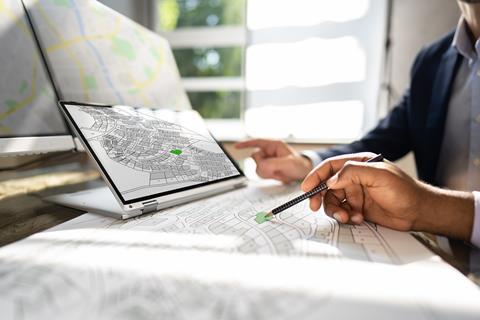As digital technologies revolutionise architecture, the industry faces new opportunities and challenges. Explore how these advancements are shaping the future of design

Digital transformation has become a buzzword commonly associated with modern business. This wide-reaching term, used to describe the wave of new digital technologies and the processes by which they’re implemented into business, is having an impact on a variety of industries, from healthcare and the public sector to agriculture and hospitality.
Architecture is no exception. Despite often being seen as a profession under threat in the wake of digitisation, new tools and innovations are in fact ushering in a new era of design, creativity, and efficiency. For architecture, digital transformation isn’t merely a buzzword – it’s the future.
4 tools changing the face of architecture
Here are just a handful of the emerging and exciting technologies bringing in architecture’s digital future:

1. Building information modelling (BIM)
BIM is so established that it may no longer qualify as an ‘innovation’. According to a report by Microsoft and the Royal Institute of British Architects (RIBA), 70% of the 300 architectural professionals they surveyed were currently making use of BIM.
However, BIM’s capabilities have yet to be fully realised. Higher ‘levels’ of BIM, currently undefined, will strive for deeper collaboration. In the future, we’ll likely see the adoption of ‘Connected BIM’, with a focus on integration.
2. Virtual and augmented reality software
Compared to BIM, the adoption of ‘immersive’ technologies like virtual reality (VR) and augmented reality (AR) are far less common. In Microsoft and RIBA’s survey, just over a third (35%) of respondents were currently making use of this technology.
VR and AR both have important applications in architecture. By presenting project designs and concepts in 3D, design teams can foster greater stakeholder engagement, particularly among clients, while also enabling collaboration with other professions.

3. Digital collaboration tools
Collaboration is a running theme across architecture’s digital transformation. The COVID-19 pandemic forced many businesses to adopt digital tools to continue their operations, and ever since they’ve reaped the benefits of enhanced collaboration.
Architecture is once again no exception. Through virtual design studios, alongside BIM, VR and AR, professionals, teams and experts can now collaborate on various components of a building project simultaneously. What’s more, digital collaboration has opened the door to remote working, which will help the architectural industry access a wider, broader and more diverse talent pool.
4. The Internet of Things (IoT)
IoT is another new technology helping architects design and create safer and more environmentally-friendly buildings. IoT tools – devices that connect to computer networks to send and relay information – are being employed in the design of smart buildings and homes to help improve efficiency and improve occupant comfort.
Why digital transformation matters
Digital transformation has wide ramifications for architecture. With sustainable development now a key focus for the built environment, architects have the responsibility to ensure their concepts and designs are practical, sustainable, and energy efficient.
What’s more, incoming legislation around safety like the Building Safety Act (BSA) make adopting new digital technologies and improving processes mandatory for businesses. For instance, the BSA requires building owners and companies to retain their building’s ‘golden thread’ – the digital catalogue of information relating to a structure’s creation that acts as a single source of truth.

So what’s holding back architecture’s digital future?
As with any organisation-wide initiative, there are various challenges all digital transformation projects face. From effective change management to sufficient budget, stakeholder engagement and siloed decision-making, it’s no surprise that the typical digital transformation journey can last for up to five years.
However, for architecture, construction, and the built environment, the key challenge is the looming skills gap, which itself consists of several different competencies:
Digital skills and technical proficiency
Tools like BIM and IoT are helping to revolutionise the way architecture works, but their implementation has given rise to a shortage of digital proficiency in the industry. Many existing professionals currently lack the digital skills to make use of these tools, and this will only be exasperated at the end of the decade, when 41% of the construction workforce are predicted to retire.
Green skills and sustainability literacy
The green skills gap is a particular challenge in the UK. With building owners and businesses under greater pressure than ever to ensure their designs and projects are both sustainable and energy-efficient, architecture professionals now need to couple their creativity and technical expertise with the green skills and sustainability literacy to understand the relationship between buildings, the environment, and its occupants.

Critical thinking and problem solving
Along with the need to make new developments sustainable, architects also must ensure their designs comply with the latest safety standards and regulations. Applying both of these new factors to design work requires critical thinking, problem solving skills, and the ability to place decision-making in the context of both occupant safety and the environment.
The solution? Level up your digital proficiency
The future of architecture is digital. In the wake of the BSA and the implementation of tools like BIM, today’s architectural firms, businesses and professionals can’t just be creative – they also need to be digitally proficient if they want to survive.
UCEM have launched the BSc Architectural Design Technology to help meet the demand from the architectural industry for the creative and digital skills that will help realise a sustainable built environment.
This programme emphasises collaboration and communication, giving students the skills to integrate their creativity with both technical expertise and sustainability knowledge.
UCEM are the only university to offer this degree as a fully online provision, and have also introduced a two-year, Level 4 Construction Design and Build Technician apprenticeship, to support growing demand from employers.
To find out more, visit the programme page: BSc (Hons) Architectural Design Technology.















